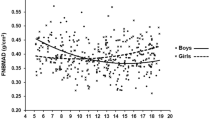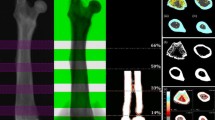Abstract
Summary
Female-derived inter-conversion and standardised BMD equations at the lumbar spine and hip have not been validated in men. This study of 110 male subjects scanned on Hologic and Lunar densitometers demonstrates that published equations may not applicable to men at the lumbar spine. Male inter-conversion equations have also been derived.
Purpose
Currently, available equations for inter-manufacturer conversion of bone mineral density (BMD) and calculation of standardised BMD (sBMD) are used in both males and females, despite being derived and validated only in women. Our aim was to test the validity of the published equations in men.
Methods
One hundred ten men underwent lumbar spine (L2-4), femoral neck (FN) and total hip (TH) dual X-ray absorptiometry (DXA) using Hologic and Lunar scanners. Hologic BMD was converted to Lunar using published equations derived from women for L2-4 and FN. Actual Lunar BMD (A-Lunar) was compared to converted (Lunar equivalent) Hologic BMD values (H-Lunar). sBMD was calculated separately using Hologic (sBMD-H) and Lunar BMD (sBMD-L) at L2-4, FN and TH. Conversion equations in men for Hologic to Lunar BMD were derived using Deming regression analysis.
Results
There was a strong linear correlation between Lunar and Hologic BMD at all skeletal sites. A-Lunar BMD was however significantly higher than derived H-Lunar BMD (p < 0.001) at L2-L4 (mean difference, 0.07 g/cm2). There was no significant difference at the FN (mean difference, 0.01 g/cm2). sBMD-L at the spine was significantly higher than sBMD-H (mean difference, 0.06 g/cm2, p < 0.001), whilst there was little difference at the FN and TH (mean difference, 0.01 g/cm2).
Conclusion
Published conversion equations for Lunar BMD to Hologic BMD, and formulae for lumbar spine sBMD, derived in women may not be applicable to men.





Similar content being viewed by others
References
Genant HK, Grampp S, Gluer CC, Faulkner KG, Jergas M, Engelke K, Hagiwara S, Van Kuijk C (1994) Universal standardization for dual X-ray absorptiometry: patient and phantom cross-calibration results. J Bone Miner Res 9(10):1503–1514
Shepherd JA, Cheng XG, Lu Y, Njeh C, Toschke J, Engelke K, Grigorian M, Genant HK (2002) Universal standardization of forearm bone densitometry. J Bone Miner Res 17(4):734–745. doi:10.1359/jbmr.2002.17.4.734
Hui SL, Gao S, Zhou XH, Johnston CC Jr, Lu Y, Gluer CC, Grampp S, Genant H (1997) Universal standardization of bone density measurements: a method with optimal properties for calibration among several instruments. J Bone Miner Res 12(9):1463–1470. doi:10.1359/jbmr.1997.12.9.1463
Lu Y, Fuerst T, Hui S, Genant HK (2001) Standardization of bone mineral density at femoral neck, trochanter and Ward’s triangle. Osteoporos Int 12(6):438–444
Looker AC, Wahner HW, Dunn WL, Calvo MS, Harris TB, Heyse SP, Johnston CC Jr, Lindsay R (1998) Updated data on proximal femur bone mineral levels of US adults. Osteoporos Int 8(5):468–489
Masharawi Y, Dar G, Peleg S, Steinberg N, Medlej B, May H, Abbas J, Hershkovitz I (2010) A morphological adaptation of the thoracic and lumbar vertebrae to lumbar hyperlordosis in young and adult females. Eur Spine J 19(5):768–773. doi:10.1007/s00586-009-1256-6
Nieves JW, Formica C, Ruffing J, Zion M, Garrett P, Lindsay R, Cosman F (2005) Males have larger skeletal size and bone mass than females, despite comparable body size. J Bone Miner Res 20(3):529–535. doi:10.1359/JBMR.041005
Naganathan V, Sambrook P (2003) Gender differences in volumetric bone density: a study of opposite-sex twins. Osteoporos Int 14(7):564–569. doi:10.1007/s00198-003-1422-3
Goodpaster BH, Thaete FL, Simoneau JA, Kelley DE (1997) Subcutaneous abdominal fat and thigh muscle composition predict insulin sensitivity independently of visceral fat. Diabetes 46(10):1579–1585
Acknowledgments
The authors would like to thank all the staff in the Department of Endocrinology and Metabolism, Concord Hospital for their enthusiastic recruitment efforts and support. Particular thanks to Beverly White, Lynley Robinson, Susie Baird, Moira Fraser, Klaus Sommer, Nicole Somer and Caroline Sullivan (Project Coordinator).
Conflicts of interest
None.
Author information
Authors and Affiliations
Corresponding author
Rights and permissions
About this article
Cite this article
Ganda, K., Nguyen, T.V. & Pocock, N. Gender disparity in BMD conversion: a comparison between Lunar and Hologic densitometers. Arch Osteoporos 9, 180 (2014). https://doi.org/10.1007/s11657-014-0180-5
Received:
Accepted:
Published:
DOI: https://doi.org/10.1007/s11657-014-0180-5




